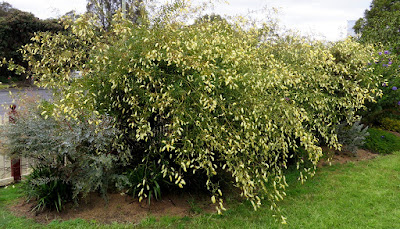Grevillea looks pretty like a wattle
I thought, from a distance, well here's a pretty wattle. Close up it revealed itself as a pretty member of the Proteaceae family and, as it turns out, a Grevillea.
Why do these grevillea flowers look like a wattle bloom - at least from a distance? (Or perhaps, why do some wattles look like this grevillea?) Probably because the colour and arrangement of flowers are attractive to the same potential pollinators.
In the east, at least, the flowers of the Zigzag Grevillea attract lots of birds and insects. Yellow flowers are generally associated with insect pollinators, and it's likely they appeal to the same beetles, wasps and bees as wattle blossom. As with wattles, birds and mammals may also assist.
Grevillea flexuosa is on the list of endangered species in Australia, and only known in the wild from rocky hills to the north-east of Perth. It was once thought to be very close to extinction but I gather an additional population discovered in recent times has raised its survival chances a little.
I haven't seen it in its natural habitat but these pictures are from a rather wet morning in Western Victoria in mid-September. The Zigzag (or Tangled) Grevillea is forming an attractive hedge bordering part of Royal Mail Hotel in Dunkeld, at the south of Victoria's Grampians range.
You see the species here and there in gardens with climate and soils suitable for growing Western Australian wildflowers, such as Dunkeld. Although I'm presuming most garden grown plants of Zigzag Grevillea in the East are grafted onto Silky Oak (Grevillea robusta) rootstock or one of the tough Grevillea hybrids. They certainly do well in Dunkeld, although it does seem to be a place where you can grow lots of Western Australian beauties (see below).
Thanks to Swiss botanist Carl Meisner, this striking species became a Grevillea the year before a patch of land beside the Yarra River in Melbourne became a botanic garden (1846). It was originally named Anadenia flexuosa by English botanist John Lindley, in his 1839 'A Sketch of the Vegetation of the Swan River Colony'. Lindley named it flexuosa to remind us of its 'curious zigzag leaves'.
Carl Meisner moved the whole genus Anadenia - established by Scottish botanist Robert Brown in 1810, six years before Sydney's botanic garden was established - to Grevillea.
You do see this species described as prostrate, getting to only 30 cm high, and with pink flowers, but presumably that is a misidentification. FloraBase - the authoritative guide to the Western Australian flora - confirms Grevillea flexuosa as having the same form as we see in cultivation over in the east, reaching two metres or so and with flowers very much creamy yellow.
Not much more to say on this one so I'll finish with few more gorgeous Western Australian blooms from the Royal Mail Hotel garden at Dunkeld, adding to my rather fawning post of seven years ago. These are all in the the same plant family as Grevillea - the Proteaceae - except of course the wattle (Acacia denticulosa) at the end for comparison with our Zigzag Grevillea...









Comments